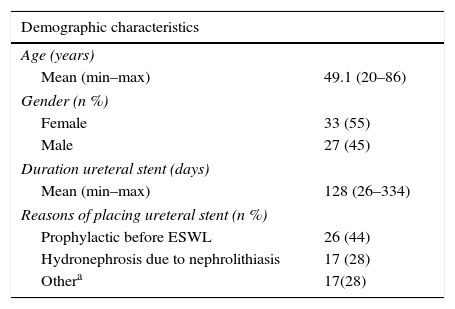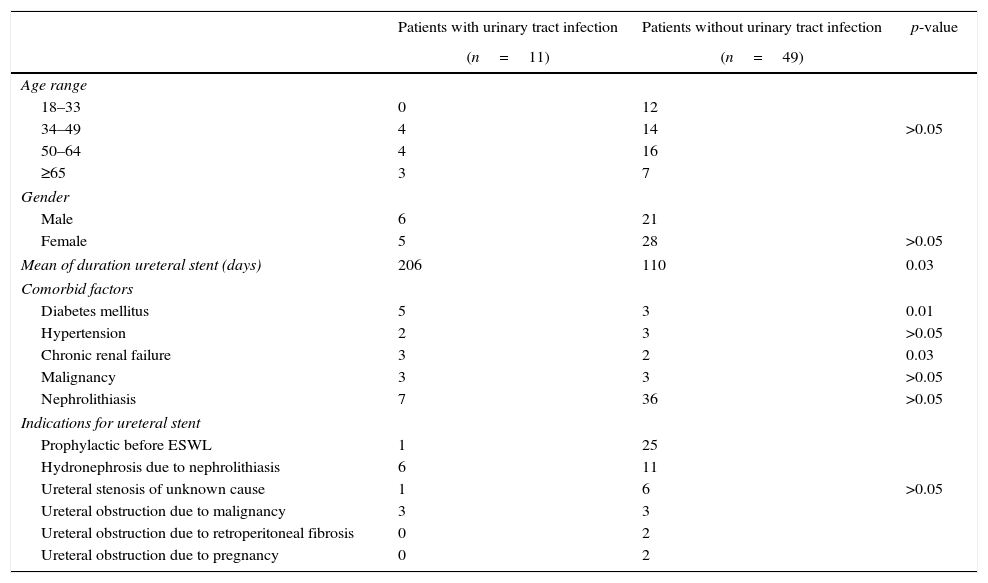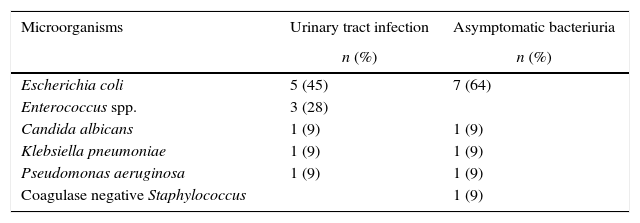Urinary tract infection is one of the most frequently seen infections in the community and also in hospitals. It can be seen in a broad clinical spectrum ranging from asymptomatic bacteriuria to acute pyelonephritis accompanied with sepsis. One of these clinical conditions is infection of the urinary system with functional or structural abnormalities. If complicated urinary tract infection is considered, pre-treatment urine culture should be taken in order to define the causative pathogen and antibiotic susceptibility pattern. Renal damage, bacteremia, sepsis and increased mortality are more likely in this group of patients. Fixing the complicating factor is equally important as antimicrobial treatment. The presence of ureteral stent is also a predisposing factor for urinary tract infection.
In recent years, the use of ureteral stents has increased in urology practice in order to provide drainage of urine. Ureteral stents lead to the formation of foreign bodies such as biofilms. Studies have revealed that biofilms formed by microorganisms are responsible for approximately 65% of nosocomial infections, which increase treatment costs significantly. As the use of ureteral stent increased, the incidence of complicated urinary tract infection, which is one of the complications of ureteral stent, also increased.1
The aim of this study was to determine the frequency of infection and asymptomatic bacteriuria and comorbid factors associated with the development of urinary tract infection in the adult patients with ureteric stent.
Between the dates August 2008 and January 2011 the patients who placed ureteral stent in our Urology Department were evaluated. Sixty patients aged 18 years and more and with sterile urine who agreed to participate in the study were asked to sign an informed consent form. After ureteral stent was placed the patients were monitored 0–30 day, 31–90 day, 91–150 day, 151–210, >210 days intervals. The association of urinary tract infection during the treatment and patients’ age, sex, underlying illnesses, reasons for ureteral stent placement, length of stent placement were analyzed.
Patients with ureteral stents were recommended to come to the hospital immediately in case of dysuria, fever, and side pain throughout the follow-up period. The patients with elevated white-blood cell (WBC), erythrocyte sedimentation rate (ESR) and CRP values who had complaints of dysuria, fever, side pain and had at least 10leukocyte/mm3 and growth 105CFU/ml bacteria in midstream clean catch urine were diagnosed as urinary tract infection.
During the follow-up period, the patients whose WBC, ESR and CRP values were normal and who did not have any complaints of dysuria, fever, side pain, but developed the same strain of bacteria in the quantitative culture technique of two different clean catch sample of urine as 105CFU/ml were diagnosed as asymptomatic bacteriuria.
The data collected were stored in SPSS 13.0 package program for statistical analysis. Student t test and chi-square test were used. Statistical significance level was fixed at p<0.05.
Sixty patients with ureteral stent were followed up prospectively during the study until ureteral stent was removed. The main features of these patients are shown in Table 1. Of the patients included in the study, 33 (55%) were female and 27 (45%) were male. Patients’ ages ranged from 20 to 86, mean 49.1±16.1. The mean duration of the ureteral stent in place was 128±77 days, ranging from 26 to 334 days, on average, median 111 days.
Characteristics of the patients.
| Demographic characteristics | |
|---|---|
| Age (years) | |
| Mean (min–max) | 49.1 (20–86) |
| Gender (n %) | |
| Female | 33 (55) |
| Male | 27 (45) |
| Duration ureteral stent (days) | |
| Mean (min–max) | 128 (26–334) |
| Reasons of placing ureteral stent (n %) | |
| Prophylactic before ESWL | 26 (44) |
| Hydronephrosis due to nephrolithiasis | 17 (28) |
| Othera | 17(28) |
ESWL, extracorporeal shockwave lithotripsy.
The main reason for placing ureteral stent was prophylactic before extracorporeal shockwave lithotripsy (ESWL), followed by hydronephrosis due to nephrolithiasis and ureteral stenosis of unknown cause.
The most common risk factors for urinary infection were diabetes mellitus and chronic renal failure. The association of risk factors with urinary tract infection is shown in Table 2.
The association of risk factors with the development of urinary tract infection.
| Patients with urinary tract infection | Patients without urinary tract infection | p-value | |
|---|---|---|---|
| (n=11) | (n=49) | ||
| Age range | |||
| 18–33 | 0 | 12 | |
| 34–49 | 4 | 14 | >0.05 |
| 50–64 | 4 | 16 | |
| ≥65 | 3 | 7 | |
| Gender | |||
| Male | 6 | 21 | |
| Female | 5 | 28 | >0.05 |
| Mean of duration ureteral stent (days) | 206 | 110 | 0.03 |
| Comorbid factors | |||
| Diabetes mellitus | 5 | 3 | 0.01 |
| Hypertension | 2 | 3 | >0.05 |
| Chronic renal failure | 3 | 2 | 0.03 |
| Malignancy | 3 | 3 | >0.05 |
| Nephrolithiasis | 7 | 36 | >0.05 |
| Indications for ureteral stent | |||
| Prophylactic before ESWL | 1 | 25 | |
| Hydronephrosis due to nephrolithiasis | 6 | 11 | |
| Ureteral stenosis of unknown cause | 1 | 6 | >0.05 |
| Ureteral obstruction due to malignancy | 3 | 3 | |
| Ureteral obstruction due to retroperitoneal fibrosis | 0 | 2 | |
| Ureteral obstruction due to pregnancy | 0 | 2 | |
ESWL, extracorporeal shockwave lithotripsy.
Eleven (18%) patients developed urinary tract infection. Longer duration of ureteral stent in place, presence of diabetes mellitus, and presence of chronic renal failure were significantly associated with the development of urinary tract infection.
Out of the 11 patients who developed urinary tract infection six had their ureteral stent changed and were given antibiotics according to the susceptibility test results. The remaining five patients who developed urinary tract infection were treated with appropriate antibiotics, but the ureteral stents were left in place. In five patients urinary tract infection relapsed after 24 days on average.
Eleven (18%) patients developed asymptomatic bacteriuria. Of those, three patients developed urinary tract infection in a period ranging from 14 to 45 days, average of 27 days.
Overall, 22 microorganisms were recovered from urine cultures, 11 from the patients with urinary tract infection and 11 from patients with asymptomatic bacteriuria. Among patients with urinary tract infection was Escherichia coli was the most commonly isolated microorganism among both patients with urinary tract infection (45%) and with asymptomatic bacteriuria (64%). The distribution of microorganisms isolated from urine cultures of patients with urinary tract infection or asymptomatic bacteriuria is shown in Table 3.
Microorganisms isolated from urine cultures of patients diagnosed with urinary tract infection or asymptomatic bacteriuria.
| Microorganisms | Urinary tract infection | Asymptomatic bacteriuria |
|---|---|---|
| n (%) | n (%) | |
| Escherichia coli | 5 (45) | 7 (64) |
| Enterococcus spp. | 3 (28) | |
| Candida albicans | 1 (9) | 1 (9) |
| Klebsiella pneumoniae | 1 (9) | 1 (9) |
| Pseudomonas aeruginosa | 1 (9) | 1 (9) |
| Coagulase negative Staphylococcus | 1 (9) |
All of the 22 bacteria isolated from urine cultures were sensitive to ertapenem, meropenem, and imipenem. Extended-spectrum beta-lactamase (ESBL) was detected in 7 (58.3%) out of 11 E. coli strains isolated from urinary tract infections.
Ureteral stents have been widely used in urology practice in the last two decades in parallel with increasing number of endourologic initiatives. Ureteral stents may lead to bacterial colonization similarly to all inserted synthetic medical devices. As the use of ureteral stents increased, the incidence of complicated urinary tract infection, which is one of the complications of ureteral stent, has also increased.
In a study investigating the colonization in ureteral stents, colonization was already detected in some stents after one day of insertion, but colonization had disappeared at the time of stent removal 38 days thereafter. Colonization depends on age, gender, comorbidity, and immunological status.2 In a study of Farsi et al., colonization varied according to the polymer characteristic of the stent; they reported bacterial colonization of 67.9%, and bacteriuria prevalence of 29.9%.3 In this study the occurrence of asymptomatic bacteriuria and urinary tract infection were investigated separately. Asymptomatic bacteriuria and urinary tract infection were diagnosed in 18%. The lower rate of asymptomatic bacteriuria compared to another study could be possibly attributed to reasons such as placing ureteral stent in elective conditions, having less comorbid diseases, and using the stent in the same polymer characteristic in each patient.
The period the ureteral stent remained in place was 75 days on average in the study made by Mohammed et al. and in another study it was 52 days.4 The time of ureteral stent remained in place has been shown to be a risk factor for the bacterial colonization. In our study, the average time with ureteral stent was 128 days. This period was found to be longer compared to other studies. In our study, similarly, prolonged time with ureteral stent increased the possibility of urinary tract infection increased (p=0.03). In the majority of the patients who developed urinary tract infection, ureteral stent remained in place for more than 150 days.
A study by Akay et al. investigated risk factors for urinary tract infection and stent colonization in 190 patients with ureteral stents. In this study, independent risk factors for the development of urinary tract infection were diabetes mellitus, chronic renal failure, and pregnancy.5 In our study, urinary tract infection was also more common in the patients with ureteral stents who were diagnosed with diabetes mellitus and chronic renal failure (p=0.01). Diabetes mellitus and chronic renal failure can be predisposing factors for the development of infection by compromising the immune system.
Urinary tract infection relapsed in five patients treated according to antibiotic susceptibility test results after 24 days of detecting urinary tract infection. This finding could have been due to the lack of effectiveness of antibiotics on bacterial colonization of the ureteral stent. In our opinion ureteral stents of the patients with urinary tract infection should be replaced after appropriate antibiotic treatment.
Urinary tract infection was detected in three patients whose ureteral stents remained in place after asymptomatic bacteriuria after an average of 27 days. Asymptomatic bacteriuria should be considered as an indicator of biofilm. In this group of patients if the indication of ureteral stent useremains and asymptomatic bacteriuria is detected, replacing the stent is thought to be an appropriate approach so as to prevent the development of urinary tract infection.
In our study, E. coli was the most commonly isolated among patients with urinary tract infections (45%), and in those with asymptomatic bacteriuria (64%). Despite the low number of cases in our study, in 12 E. coli strains evaluated, there were 58% extended-spectrum beta-lactamase (ESBL), 67% trimethoprim/sulfamethoxazole resistant, 58% ciprofloxacin resistant, 58% ceftriaxone resistant. The high positivity rate of ESBL, as well high resistance rates for trimethoprim/sulfamethoxazole, ciprofloxacin, and ceftriaxone may be due to inserting the stent in the hospital environment, and stent presence resulting in complicated urinary tract infections.
Antibiotic or bactericide coated stents are on the agenda in the recent years in order to prevent bacterial colonization. However, despite the advances today, the ideal stent that does not cause any complications has not been produced so far. Our study was potentially limited by its observational design and small sample size. Despite these limitations, our study presents a picture of infection and asymptomatic bacteriuria and comorbid factors associated with the development of urinary tract infection in the adult patients with ureteric stent. Therefore it is thought as an appropriate approach that the patients with ureteral stent should be informed about the symptoms of urinary tract infection and should be closely followed up so as to minimize complications. In particular, we think that patients diagnosed with diabetes mellitus, chronic renal failure, or those who need ureteral stent for a long time should come to the hospital immediately when symptoms like dysuria, side pain, or fever occurs.
Conflicts of interestThe authors declare no conflicts of interest.
The manuscript was presented as a poster in KLİMİK 2013 and ICAAC 2013.







